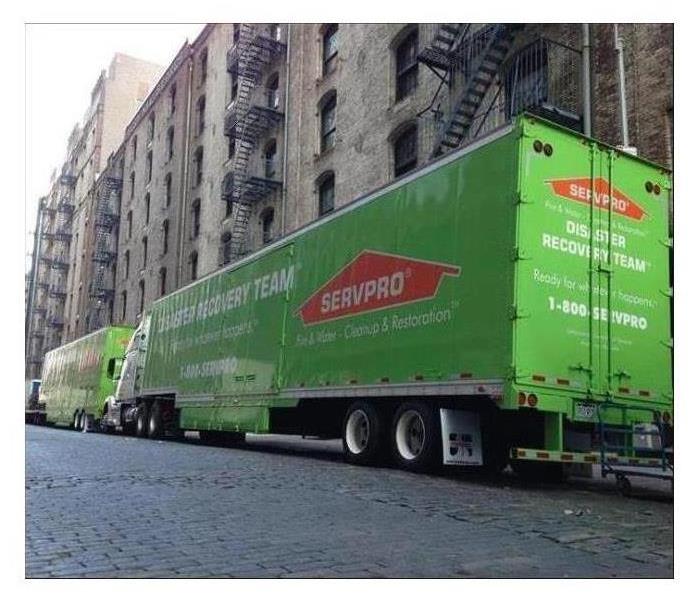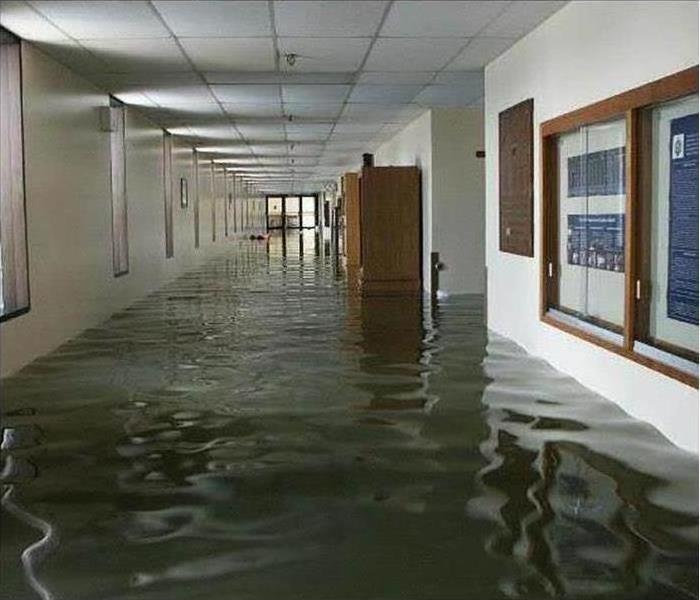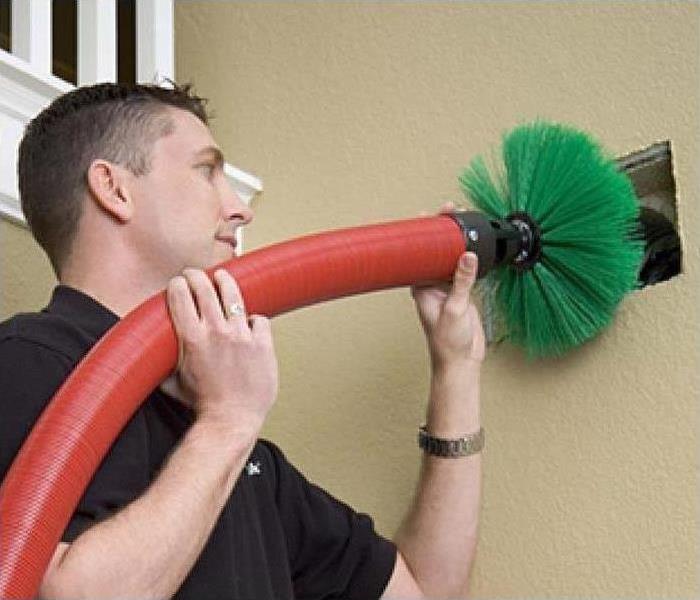Archived Commercial Blog Posts
How to Use Building Envelopes to Keep Your Property Dry
12/20/2022 (Permalink)
Rain damage can harm a commercial building in several ways. It creates an overflow of water, which may necessitate expensive flood cleanup. The water can destroy both the structure of a building and the contents inside it. Rain damage can also lead to a buildup of black mold.
Thankfully, there are ways to prevent major storm damage to your property. One common tactic is securing the building envelope. This envelope consists of the wall systems and the roof, and it has several functions. They include:
- Resisting the escape of cool or hot air
- Diverting water to the storm drains
- Protecting and supporting equipment
- Defending the building from snow or rain
Securing the Envelope
Water penetration is responsible for the majority of harm to buildings. Flood damage, in particular, can be costly. Worst of all, water does not need a lot of space to get inside a property. A hole as small as 0.005 inches is all it takes.
This hole can result from cracks in the plaster and brick that make up the walls. Poorly installed joints can cause gaps, as well. To limit the rain damage to your property, be sure to seal as many of these openings as possible.
Designing the Envelope
When building or remodeling the envelope for your property, you should take certain additional steps to keep the area secure. If possible, limit the number of protrusions you use. You should also avoid using too many different cladding materials. You may want to include rain screens and capillary breaks, as well.
There are backup systems you can install, too. You can utilize weep holes that drain excess water to the outside of the building. You can also use through-wall flashing to divert moisture to the exterior.
Proper maintenance of your commercial building envelope can prevent rain damage. However, if your property does sustain a leak, storm cleanup specialists can assist with the restoration process.
How to Eliminate Mold in Ductwork
7/1/2022 (Permalink)
How To Eliminate Mold In Ductwork
High levels of moisture can cause mold to start growing inside HVAC ducts. Almost any type of mold, including black mold, can be supported by dust and debris inside of a heating and cooling system. Spores can spread throughout a structure through air ducts. If a musty odor is present or mold growth is evident, building owners or managers should take these three steps.
1. Locate the Source of Moisture
A building owner or manager should contact an HVAC specialist to identify the source of moisture and resolve the problem before scheduling a duct cleaning. Excessive moisture or mold growth may be evident in condensate drip pans, coils, or terminal units. It is also possible that a plumbing or roof leak is introducing water directly into the ductwork.
2. Clean the Air Ducts
A duct cleaning company can eliminate many types of mold. These services typically use high-powered vacuums to clean ducts. If black mold or signs of severe contamination are present, a property owner or manager may also want to consult with an indoor environmental professional. More extensive remediation work may be necessary if mold has spread beyond ducts.
3. Inhibit the Mold Growth
A duct cleaning company may also apply a mold inhibitor rated for HVAC use. This treatment can help to prevent mold from returning even if moisture levels increase. Property owners should keep moisture low by taking measures to prevent and quickly fix leaks, maintaining the HVAC system, and ensuring that indoor relative humidity levels remain between 30 percent and 50 percent.
These measures can help eliminate the presence of mold growth from ductwork and prevent fungus from returning. If black mold is found or there is a significant chance that mold has spread to other parts of a structure, a property owner or manager should also contact a mold cleanup and remediation company in Kansas City, MO.
How Do Building Envelopes Work?
7/1/2022 (Permalink)
As a business owner in Unity Village, MO, you know how crucial it is to keep your building safe from all kinds of harm. One of the most dangerous risks that you may face is persistent rain damage. This threat can lead to various problems throughout your business, such as flooding and black mold. Fortunately, you can ensure that your company stays protected by establishing a secure envelope around your building. Here’s everything you need to know about how building envelopes work.
What Are Building Envelopes?
A building envelope refers to the construction and design of a building’s exterior that helps to repel the elements. There are numerous aspects of an envelope that allow it to do its job of keeping a building safe. Some of its most essential features include the following:
- Structural integrity
- Air pressure boundaries
- Temperature control
- Moisture control
Each of these elements plays a critical role in the effectiveness of a building’s envelope. It’s crucial to ensure that your envelope is shielded with these features so that it stays safe from rain damage.
The Importance of Building Envelopes
If you aim to keep your business protected from weather damage, the first place you should look is your building envelope. This structure acts as a major defense against rain, snow, hail, and various other types of water and air intrusion. Once a building’s envelope captures excess water, it sends the water to a drainage system, helping to prevent black mold from forming in your business. A strong envelope around your building also helps to regulate the transfer of heat in and out of your business, which ensures that your employees and customers stay comfortable all year long.
Rain damage can have a severe impact on your business, and strengthening your building’s envelope may help to deter some of the harm. If your company suffers any damage despite having a powerful building envelope, be sure to call commercial building restoration services so your building can make a full recovery.
Tasks Property Managers Should Do to Prepare for a Storm
4/16/2022 (Permalink)
As a property manager, there are several tasks you should take to prepare for a storm. Here are some steps you can take:
Create an emergency plan: Create an emergency plan that outlines what your team should do in the event of a storm. This plan should include evacuation procedures, emergency contacts, and a checklist of tasks that need to be completed before and after the storm.
Inspect the property: Inspect the property for any potential hazards, such as loose roof tiles, trees that could fall, or loose objects that could become projectiles in high winds. Address any hazards that you identify before the storm arrives.
Secure loose objects: Secure all outdoor furniture, signage, and other loose objects to prevent them from becoming dangerous projectiles in high winds.
Ensure proper drainage: Make sure that all drainage systems are clear and functioning properly. This will help prevent flooding and water damage.
Stock up on supplies: Stock up on supplies such as sandbags, emergency lighting, first aid kits, and non-perishable food items. You should also make sure that you have enough fuel for backup generators, if necessary.
Communicate with tenants: Keep your tenants informed about the storm and what to expect. Let them know what you are doing to prepare and what they can do to stay safe.
Stay informed: Stay up-to-date on the latest weather forecasts and warnings. This will help you make informed decisions about when to take action and how to keep your property safe.
How Do Building Envelopes Work?
3/7/2022 (Permalink)
Building envelopes are the physical barriers that separate the indoor and outdoor environments of a building. They are designed to provide a range of functions, including insulation, air and moisture control, and protection from the elements.
The building envelope typically consists of several layers, each with its own specific function. The outermost layer is often the cladding, which is the visible exterior surface of the building. Cladding materials can vary widely and can include materials such as brick, stone, metal, or glass. The cladding provides protection against weather, as well as an aesthetic finish to the building.
Behind the cladding is the insulation layer, which is designed to reduce heat loss and gain through the building envelope. Insulation can be made from a variety of materials, such as fiberglass, foam, or cellulose, and is typically installed within the walls, floors, and roof of the building.
The air barrier layer is typically located behind the insulation layer and is designed to control the movement of air through the building envelope. It is typically made of airtight materials, such as plastic sheeting or spray foam, and is designed to prevent air leakage and reduce energy costs.
The vapor barrier layer is located on the warm side of the insulation and is designed to control the movement of moisture through the building envelope. It is typically made of plastic or foil and helps to prevent moisture from accumulating within the building envelope, which can lead to mold and structural damage.
Finally, the structural layer is the load-bearing layer of the building envelope that supports the weight of the building and distributes it to the foundation. This layer is typically made of materials such as wood, steel, or concrete, and is designed to withstand the forces of wind, snow, and seismic activity.
Together, these layers work to create a functional and energy-efficient building envelope that protects the building from the elements, while also providing a comfortable and healthy indoor environment.
Important Facts About Mold Growth
1/19/2022 (Permalink)
It always pays to have a little bit of knowledge about certain subjects, and knowing a few facts about mold growth is a good idea. This information may help your business prevent the growth of mold, as well as help to rectify the situation if mold is found. Everyone should know these three facts about mold:
- Mold is a naturally occurring fungus that is found just about everywhere in small amounts
- Mold thrives in damp conditions of high humidity
- Mold can degrade indoor air quality and be an irritant or allergen to many people
A few other facts are relevant here. Mold often exudes a musty odor. Finally, mold spores are microscopic and can be spread throughout a building through the heating and cooling system.
Proven Steps for Mold Cleanup
When mold growth is discovered at your business in Lone Jack, MO, it should be looked into immediately. Calling in a mold mitigation team that is Faster to Any Size Disaster is the place to begin. Each situation is unique, but the process for mold remediation is similar in most respects. It begins with an inspection and damage assessment and looks for instances of water damage, which often paved the way for mold to grow in a commercial building. These initial measures are followed by mold containment and air filtration and then the removal and cleaning of materials affected by mold. The final stages include content cleaning and restoration.
Positive Results
It is essentially impossible to remove every last vestige of mold spores from a building. However, with the right techniques and equipment, mold growth can be stopped to the point where it does not pose a problem for employees and customers. The removal of mold colonies will also address the appearance of the workplace, and the musty odor will be gone, too. With a better understanding of mold, your company can deal with the issue effectively.
How to Use Building Envelopes to Keep Your Property Dry
12/20/2021 (Permalink)
Rain damage can harm a commercial building in several ways. It creates an overflow of water, which may necessitate expensive flood cleanup. The water can destroy both the structure of a building and the contents inside it. Rain damage can also lead to a buildup of black mold.
Thankfully, there are ways to prevent major storm damage to your property. One common tactic is securing the building envelope. This envelope consists of the wall systems and the roof, and it has several functions. They include:
- Resisting the escape of cool or hot air
- Diverting water to the storm drains
- Protecting and supporting equipment
- Defending the building from snow or rain
Securing the Envelope
Water penetration is responsible for the majority of harm to buildings. Flood damage, in particular, can be costly. Worst of all, water does not need a lot of space to get inside a property. A hole as small as 0.005 inches is all it takes.
This hole can result from cracks in the plaster and brick that make up the walls. Poorly installed joints can cause gaps, as well. To limit the rain damage to your property, be sure to seal as many of these openings as possible.
Designing the Envelope
When building or remodeling the envelope for your property, you should take certain additional steps to keep the area secure. If possible, limit the number of protrusions you use. You should also avoid using too many different cladding materials. You may want to include rain screens and capillary breaks, as well.
There are backup systems you can install, too. You can utilize weep holes that drain excess water to the outside of the building. You can also use through-wall flashing to divert moisture to the exterior.
Proper maintenance of your commercial building envelope can prevent rain damage. However, if your property does sustain a leak, storm cleanup specialists can assist with the restoration process.
How Do Building Envelopes Work?
7/1/2021 (Permalink)
As a business owner in Unity Village, MO, you know how crucial it is to keep your building safe from all kinds of harm. One of the most dangerous risks that you may face is persistent rain damage. This threat can lead to various problems throughout your business, such as flooding and black mold. Fortunately, you can ensure that your company stays protected by establishing a secure envelope around your building. Here’s everything you need to know about how building envelopes work.
What Are Building Envelopes?
A building envelope refers to the construction and design of a building’s exterior that helps to repel the elements. There are numerous aspects of an envelope that allow it to do its job of keeping a building safe. Some of its most essential features include the following:
- Structural integrity
- Air pressure boundaries
- Temperature control
- Moisture control
Each of these elements plays a critical role in the effectiveness of a building’s envelope. It’s crucial to ensure that your envelope is shielded with these features so that it stays safe from rain damage.
The Importance of Building Envelopes
If you aim to keep your business protected from weather damage, the first place you should look is your building envelope. This structure acts as a major defense against rain, snow, hail, and various other types of water and air intrusion. Once a building’s envelope captures excess water, it sends the water to a drainage system, helping to prevent black mold from forming in your business. A strong envelope around your building also helps to regulate the transfer of heat in and out of your business, which ensures that your employees and customers stay comfortable all year long.
Rain damage can have a severe impact on your business, and strengthening your building’s envelope may help to deter some of the harm. If your company suffers any damage despite having a powerful building envelope, be sure to call commercial building restoration services so your building can make a full recovery.
How To Eliminate Mold in Ductwork
7/1/2021 (Permalink)
How To Eliminate Mold In Ductwork
High levels of moisture can cause mold to start growing inside HVAC ducts. Almost any type of mold, including black mold, can be supported by dust and debris inside of a heating and cooling system. Spores can spread throughout a structure through air ducts. If a musty odor is present or mold growth is evident, building owners or managers should take these three steps.
1. Locate the Source of Moisture
A building owner or manager should contact an HVAC specialist to identify the source of moisture and resolve the problem before scheduling a duct cleaning. Excessive moisture or mold growth may be evident in condensate drip pans, coils, or terminal units. It is also possible that a plumbing or roof leak is introducing water directly into the ductwork.
2. Clean the Air Ducts
A duct cleaning company can eliminate many types of mold. These services typically use high-powered vacuums to clean ducts. If black mold or signs of severe contamination are present, a property owner or manager may also want to consult with an indoor environmental professional. More extensive remediation work may be necessary if mold has spread beyond ducts.
3. Inhibit the Mold Growth
A duct cleaning company may also apply a mold inhibitor rated for HVAC use. This treatment can help to prevent mold from returning even if moisture levels increase. Property owners should keep moisture low by taking measures to prevent and quickly fix leaks, maintaining the HVAC system, and ensuring that indoor relative humidity levels remain between 30 percent and 50 percent.
These measures can help eliminate the presence of mold growth from ductwork and prevent fungus from returning. If black mold is found or there is a significant chance that mold has spread to other parts of a structure, a property owner or manager should also contact a mold cleanup and remediation company in Kansas City, MO.
4 Tasks Property Managers Should Do To Prepare for a Storm
4/16/2021 (Permalink)
Commercial property can't be completely ignored when inclement weather comes through, and business owners can't control all elements of storm preparedness, especially if they lease space. With that in mind, managers must take action, doing what they can to protect the assets. Here are four things they can do to help.
1. Establish Communication
Regular updates are important. People need to know if the area is safe or whether evacuation and boarding should occur. Furthermore, everyone should be on the same page about how to prepare for the storm and who has what responsibility. Therefore, property management should compile a list of everyone's phone numbers and email addresses. Send messages often, ensuring that everyone is aware of your progress.
2. Have a Plan
Well before a system appears, sit down and discuss the protocol for storm preparedness. Gather together and upload online important legal and financial documents: This includes contracts, mortgage papers, bank account numbers, and insurance policies. In addition, think ahead of whom to call in an emergency.
3. Prepare the Grounds
Once a watch is issued, property management should begin looking at the facility. Are the shingles loose on the roofs? If so, have them secured or covered. Does the pool area require attention? Have employees clear the deck of any furniture. Also, walk around. Trim tree branches, and pick up any loose debris. Eliminate objects that could be become projectiles from the high winds.
4. Record the Property
Before the gales hit, grab your phone and videotape the building. Make sure this has a timestamp, verifying for insurance that you did attend to the location. Should leaks or structural problems occur, this evidence may help expedite the approval for a storm restoration company's services.
Be proactive. Management companies should consider storm preparedness early, mapping out their tasks and establishing a strong line of contact. Protect the space. It's valuable to many.
How Do Building Envelopes Work?
3/7/2021 (Permalink)
As a business owner in Missouri, you know how crucial it is to keep your building safe from all kinds of harm. One of the most dangerous risks that you may face is persistent rain damage. This threat can lead to various problems throughout your business, such as flooding and black mold. Fortunately, you can ensure that your company stays protected by establishing a secure envelope around your building. Here’s everything you need to know about how building envelopes work.
What Are Building Envelopes?
A building envelope refers to the construction and design of a building’s exterior that helps to repel the elements. There are numerous aspects of an envelope that allow it to do its job of keeping a building safe. Some of its most essential features include the following:
- Structural integrity
- Air pressure boundaries
- Temperature control
- Moisture control
Each of these elements plays a critical role in the effectiveness of a building’s envelope. It’s crucial to ensure that your envelope is shielded with these features so that it stays safe from rain damage.
The Importance of Building Envelopes
If you aim to keep your business protected from weather damage, the first place you should look is your building envelope. This structure acts as a major defense against rain, snow, hail, and various other types of water and air intrusion. Once a building’s envelope captures excess water, it sends the water to a drainage system, helping to prevent black mold from forming in your business. A strong envelope around your building also helps to regulate the transfer of heat in and out of your business, which ensures that your employees and customers stay comfortable all year long.
Rain damage can have a severe impact on your business, and strengthening your building’s envelope may help to deter some of the harm. If your company suffers any damage despite having a powerful building envelope, be sure to call commercial building restoration services so your building can make a full recovery.
Important Facts About Mold Growth
1/19/2021 (Permalink)
It always pays to have a little bit of knowledge about certain subjects, and knowing a few facts about mold growth is a good idea. This information may help your business prevent the growth of mold, as well as help to rectify the situation if mold is found. Everyone should know these three facts about mold:
- Mold is a naturally occurring fungus that is found just about everywhere in small amounts
- Mold thrives in damp conditions of high humidity
- Mold can degrade indoor air quality and be an irritant or allergen to many people
A few other facts are relevant here. Mold often exudes a musty odor. Finally, mold spores are microscopic and can be spread throughout a building through the heating and cooling system.
Proven Steps for Mold Cleanup
When mold growth is discovered in your business, it should be looked into immediately. Calling in a mold mitigation team that is Faster to Any Size Disaster is the place to begin. Each situation is unique, but the process for mold remediation is similar in most respects. It begins with an inspection and damage assessment and looks for instances of water damage, which often paved the way for mold to grow in a commercial building. These initial measures are followed by mold containment and air filtration and then the removal and cleaning of materials affected by mold. The final stages include content cleaning and restoration.
Positive Results
It is essentially impossible to remove every last vestige of mold spores from a building. However, with the right techniques and equipment, mold growth can be stopped to the point where it does not pose a problem for employees and customers. The removal of mold colonies will also address the appearance of the workplace, and the musty odor will be gone, too. With a better understanding of mold, your company can deal with the issue effectively.
How To Use Building Envelopes To Keep Your Property Dry
12/20/2020 (Permalink)
Rain damage can harm a commercial building in several ways. It creates an overflow of water, which may necessitate expensive flood cleanup. The water can destroy both the structure of a building and the contents inside it. Rain damage can also lead to a buildup of toxic black mold.
Thankfully, there are ways to prevent major storm damage to your property. One common tactic is securing the building envelope. This envelope consists of the wall systems and the roof, and it has several functions. They include:
- Resisting the escape of cool or hot air
- Diverting water to the storm drains
- Protecting and supporting equipment
- Defending the building from snow or rain
Securing the Envelope
Water penetration is responsible for the majority of harm to buildings. Flood damage, in particular, can be costly. Worst of all, water does not need a lot of space to get inside a property. A hole as small as 0.005 inches is all it takes.
This hole can result from cracks in the plaster and brick that make up the walls. Poorly installed joints can cause gaps, as well. To limit the rain damage to your property, be sure to seal as many of these openings as possible.
Designing the Envelope
When building or remodeling the envelope for your property, you should take certain additional steps to keep the area secure. If possible, limit the number of protrusions you use. You should also avoid using too many different cladding materials. You may want to include rain screens and capillary breaks, as well.
There are backup systems you can install, too. You can utilize weep holes that drain excess water to the outside of the building. You can also use through-wall flashing to divert moisture to the exterior.
Proper maintenance of your commercial building envelope can prevent rain damage. However, if your property does sustain a leak, storm cleanup specialists can assist with the restoration process.
How a Mitigation Company Can Help Rebuild Your Business
6/30/2020 (Permalink)
When you’re facing fire damage in your business, it can be overwhelming to think about how to begin the rebuilding process. However, consulting a professional fire mitigation company can help to alleviate the destruction caused by the fire incident. If you’re ready to call for help and begin restoring your business, this guide gives you an overview of the mitigation process.
Assessing the Situation
When mitigation professionals arrive at your business, they assess the damage that your building has sustained in the aftermath of the fire. Some of the forms of damage that they inspect may include:
- Smoke damage
- Soot damage
- Water damage (from firefighting efforts)
These types of harm may be present in addition to fire damage caused by direct contact with flames. Professionals can help you determine what the degree of destruction is in your business.
Protecting Against Additional Harm
Examining the extent of damage to your commercial building allows mitigation specialists to prevent further harm from taking place. If your building has any missing walls or windows, professionals can board up these surfaces. They may also place tarps on the roof if it has been damaged as well. Moreover, having your business protected from additional damage can help when an insurance adjuster visits to inspect the state of your building.
Cleaning and Restoration
Finally, fire mitigation professionals clean any damaged items in your building and work on restoring your business. The steps in this process depend on the extent of damage that you are experiencing. If there are any signs of water damage, restoration specialists can remove and dry excess water. Likewise, they may clean any surfaces in your building that contain traces of soot or smoke.
Whether the restoration process involves minor repairs or a full reconstruction, mitigation professionals can improve the condition of your business. Be sure to call a specialist immediately to help you rebuild, no matter what type of fire damage you’re facing.
Forgotten Causes of Commercial Water Damage
6/30/2020 (Permalink)
Business owners usually think commercial water damage is caused by floods, massive rains, and storms. That’s often true. Weather events, storms, and flooding do shut down businesses and create major water damage in commercial buildings. Unfortunately, many business owners, commercial space renters, and entrepreneurs don’t think about and try to prevent other typical causes of water damage.
1. Sprinkler systems
Some older office and retail buildings have outdated sprinkler systems that work in conjunction with fire protection systems. While sprinklers can come in handy during a fire emergency, they can also cause commercial flood damage if they are faulty, not well maintained, or in need of replacement. Many a time a poor sprinkler system has damaged commercial inventory and business assets and shut down business. Check your system to make sure that it’s not faulty or in need of repair or replacement.
2. Appliances and equipment
Restaurants and catering businesses sometimes suffer water damage from their appliances or equipment. But any business that has appliances or equipment that use water could suffer water damage. If an appliance fails and spews water across your commercial building, especially during late hours when no one is around, you may come back to work and face a water damage emergency.
3. Pipes and plumbing
Just like in a residential home, the plumbing system in a commercial business can fail. A broken pipe or faulty plumbing can result in major water damage in just a few hours.
4. Sewer lines
Sewer backups are another cause of commercial water damage that often catches business owners by surprise. Should the sewer line to your building back up or become damaged, realize the potential dangers of contaminated black water which can cause health issues and ruin products and office furnishings.
5. Water Heaters
Water heaters in commercial buildings can crack or lose their seal because of high pressure. You want to make sure and follow the manufacturers guidelines and flush your water heater regularly to make sure it is working properly.
6. Roofing
One of the more obvious ways commercial buildings suffer water damage is through an old or leaky roof. Inspect the roof frequently (at least every six months) to make sure it does not need to be reseal and to be sure it drains properly. Even small leaks should be fixed immediately.
Mold in the Building? Take These Steps Immediately
6/25/2020 (Permalink)
You go about your business each day at work focused on the tasks at hand. You probably give little thought to issues such as mold cleanup and fungal growth. However, if you come across this concern, it could cause great alarm for you and everyone in your workplace. On the bright side, there are some effective actions you can take when you discover this nasty substance.
Don’t Delay
The second you discover mold spores in your building, take appropriate action. Don’t shrug it off or procrastinate. This could only make matters worse and result in bigger concerns. Here are some essential steps:
- Get in touch with the building manager.
- Take some pictures.
- Call a professional mold cleanup company.
- Contact your commercial building insurance company.
Inform the Property Manager
It’s important that you speak with the building manager about the situation so he or she can take necessary steps to prevent further mold contamination. The building manager will apprise other tenants of the situation.
Take Photos
This is an important step when you speak with a cleanup team and with your insurance agent. You want to document the extent of the damage and what type of mold is present in your office.
Call the Pros
This might be the most crucial step in the process. Mold cleanup isn’t something you should handle on your own. There are trained, capable professionals who have the equipment to thoroughly dispose of the mold in your building. The team will also clean and sanitize the area so you can rest easy knowing all the mold is gone.
Speak With the Insurance Provider
Your insurance plan may have provisions where it covers mold and all cleanup and restoration efforts. Discuss your concerns with your insurance agent and ensure that you understand your policy completely.
Quick action and mold cleanup is essential when you find mold at work. Get a professional crew on the job, and you should be in good shape.
How Do Building Envelopes Work?
3/3/2020 (Permalink)
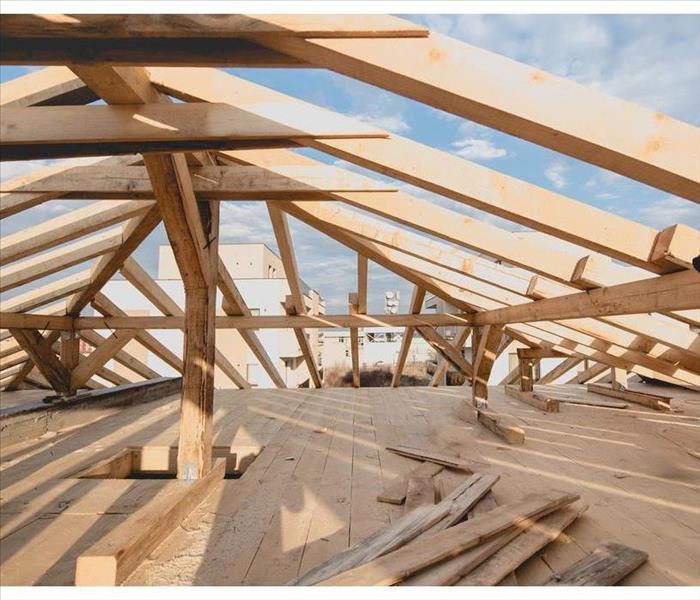 If you aim to keep your business protected from weather damage, the first place you should look is your building envelope
If you aim to keep your business protected from weather damage, the first place you should look is your building envelope
As a business owner in Unity Village, MO, you know how crucial it is to keep your building safe from all kinds of harm. One of the most dangerous risks that you may face is persistent rain damage. This threat can lead to various problems throughout your business, such as flooding and black mold. Fortunately, you can ensure that your company stays protected by establishing a secure envelope around your building. Here’s everything you need to know about how building envelopes work.
What Are Building Envelopes?
A building envelope refers to the construction and design of a building’s exterior that helps to repel the elements. There are numerous aspects of an envelope that allow it to do its job of keeping a building safe. Some of its most essential features include the following:
- Structural integrity
- Air pressure boundaries
- Temperature control
- Moisture control
Each of these elements plays a critical role in the effectiveness of a building’s envelope. It’s crucial to ensure that your envelope is shielded with these features so that it stays safe from rain damage.
The Importance of Building Envelopes
If you aim to keep your business protected from weather damage, the first place you should look is your building envelope. This structure acts as a major defense against rain, snow, hail and various other types of water and air intrusion. Once a building’s envelope captures excess water, it sends the water to a drainage system, helping to prevent black mold from forming in your business. A strong envelope around your building also helps to regulate the transfer of heat in and out of your business, which ensures that your employees and customers stay comfortable all year long.
Rain damage can have a severe impact on your business, and strengthening your building’s envelope may help to deter some of the harm. If your company suffers any damage despite having a powerful building envelope, be sure to call commercial building restoration services so your building can make a full recovery.
Black Mold and Air Ducts: A Dangerous Combination
1/6/2020 (Permalink)
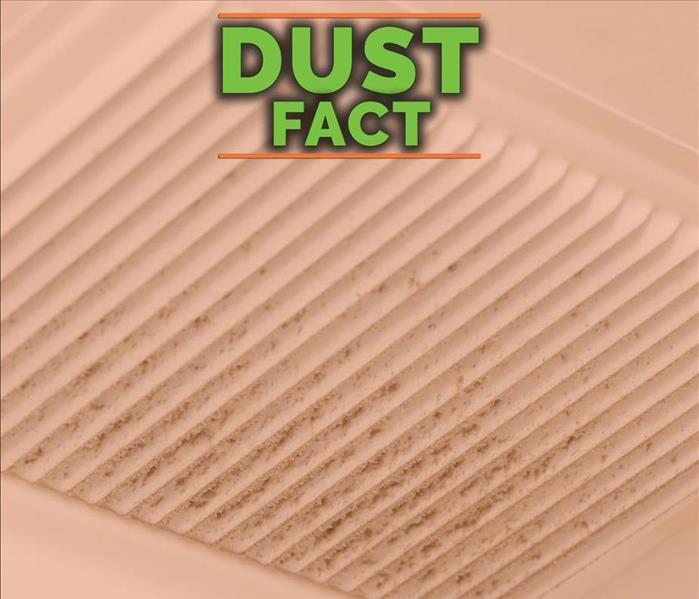 Dust that accumulates in your air ducts can lead to microbial growth
Dust that accumulates in your air ducts can lead to microbial growth
While the presence of black mold anywhere in your Kansas City, MO, commercial property is always a nuisance, it can be especially troublesome if it grows inside the air ducts. The air system can spread the mold throughout the entire location, increasing the damage around the area and endangering the health of anyone nearby, including employees and clients. Continue reading to learn more about the mold, how to remove it and how to prevent it in a timely manner.
Understanding the Mold
This type of mold, also known as Stachybotrys Chartarum, is distinct due to its darker hues of green or gray. This fungus feeds on organic matter such dust, cotton and wood. Due to its feeding habits, it is attracted to carpeting, walls, insulation and other locations that have organic material, as well as moist or isolated places. Filthy air vents and ducts can create the perfect habitat for mold.
Removal Process
If you suspect there is black mold within your air system, you will need to contact professional mold remediation. The specialists providing this service take a multi-step approach to the situation.
Inspect ducts to confirm mold
Remove and replace affected insulation
Disinfect and clean ducts using appropriate tools
Find source of mold and eliminate it
This process may become more complex depending on each case. It is crucial to detect the signs immediately and call for assistance.
Preventing the Mold
The best way to prevent mold inside your air ducts is by disrupting the perfect environment for its growth. You can stop dust buildup by changing the air filter regularly and cleaning the systems at least twice a year. Additionally, control the building's moisture by improving ventilation and fixing water damage, since humidity can also attract mold.
Black mold can not only thrive in the air system, but it can also spread throughout your property and create many problems. Attentiveness and decisive action can halt the situation before it begins.
How To Use Building Envelopes To Keep Your Property Dry
12/18/2019 (Permalink)
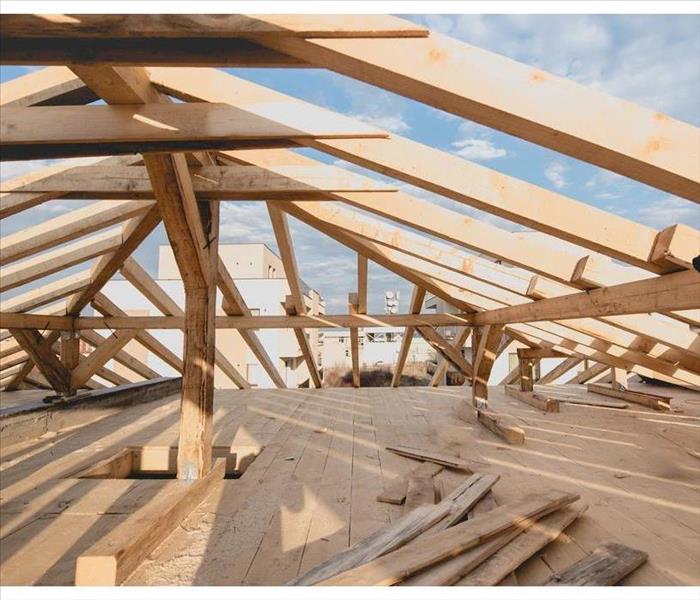 When building or remodeling the envelope for your property, you should take certain additional steps to keep the area secure
When building or remodeling the envelope for your property, you should take certain additional steps to keep the area secure
How To Use Building Envelopes To Keep Your Property Dry
Rain damage can harm a Unity Village, MO, commercial building in several ways. It creates an overflow of water, which may necessitate expensive flood cleanup. The water can destroy both the structure of a building and the contents inside it. Rain damage can also lead to a buildup of toxic black mold.
Thankfully, there are ways to prevent major storm damage to your property. One common tactic is securing the building envelope. This envelope consists of the wall systems and the roof, and it has several functions. They include:
- Resisting the escape of cool or hot air
- Diverting water to the storm drains
- Protecting and supporting equipment
- Defending the building from snow or rain
Securing the Envelope
Water penetration is responsible for the majority of harm to buildings. Flood damage, in particular, can be costly. Worst of all, water does not need a lot of space to get inside a property. A hole as small as 0.005 inches is all it takes.
This hole can result from cracks in the plaster and brick that make up the walls. Poorly installed joints can cause gaps, as well. To limit the rain damage to your property, be sure to seal as many of these openings as possible.
Designing the Envelope
When building or remodeling the envelope for your property, you should take certain additional steps to keep the area secure. If possible, limit the number of protrusions you use. You should also avoid using too many different cladding materials. You may want to include rain screens and capillary breaks, as well.
There are backup systems you can install, too. You can utilize weep holes that drain excess water to the outside of the building. You can also use through-wall flashing to divert moisture to the exterior.
Proper maintenance of your commercial building envelope can prevent rain damage. However, if your property does sustain a leak, storm cleanup specialists can assist with the restoration process.
Emergency Board Up Services
10/29/2019 (Permalink)
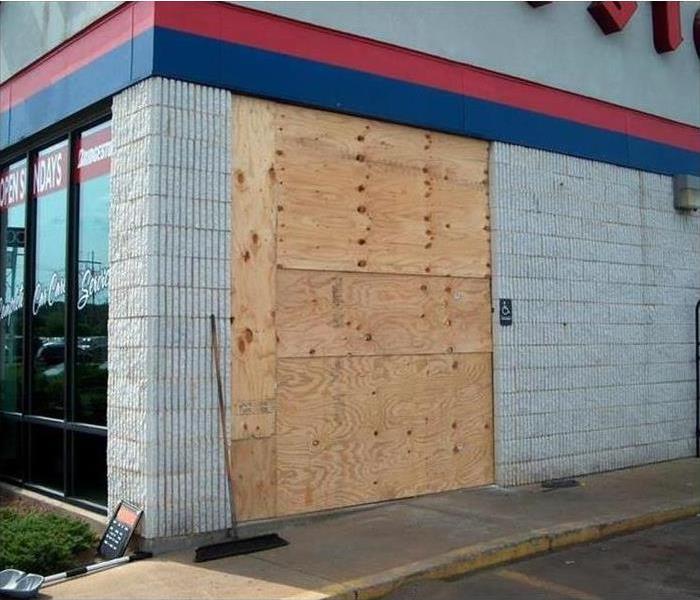 Need Emergency Board Up Services? Contact SERVPRO of Raytown/East Kansas City today to schedule an appointment: 816-737-8776
Need Emergency Board Up Services? Contact SERVPRO of Raytown/East Kansas City today to schedule an appointment: 816-737-8776
If your home or business incurs storm or fire damage resulting in an opening in your building you may be in need of emergency board up services. Any openings in the structure needs to be properly boarded up to protect the building from weather and illegal entry. Your insurance policy also requires you to be proactive on protecting your home or business after any type of damage has occurred, otherwise the insurance company could account any further/secondary damage to the structure as negligence.
Not every situation requires the most extensive board up that the U.S Fire Administration have in their board up procedure manual, such as after a fire where the entire home is destroyed and is considered a complete loss. While each emergency board up is different, let’s take a look at how to properly board up a structure after damage has caused an opening in the building.
Determining How Much Protection Is Needed
- Openings in the basement, first floor doors, windows and any point of entry accessible from a porch, fire escape or other potential climbing point require additional security measures. These openings should be barricaded with plywood, 2x4s, bolts and nails.
- Openings that are at least 10′ from ground level which are not accessible from a porch, fire escape, roof, or other climbing point can be secured with nails in each brace, and every 12″ around the perimeter. For these openings the plywood should be fitted so that it rests snugly against the exterior frame, butting up to the siding on wood frame buildings and up to the brickwork on brick buildings. It may be necessary to remove the staff bead so this fit can be flush and tight.
Boarding Up
- Cut plywood to fit over the window and door openings, flush with outside of the molding. Note: For buildings with metal door and window frames the alternative is to cut the plywood and 2x4s to fit the inside of the door frame buffed up against the band molding.
- Cut the 2x4s to fit the horizontal dimension of the plywood. You will need two 2×4 exterior and two interior braces for each window and three sets for each door. Note: For buildings with metal doors and window frames the 2x4s for the outside will be cut to the dimensions of the plywood, fitting inside the door frame, against the band molding. For the inside the 2x4s will be cut to the outside dimension of the door or window frame.
- Pre drill 3/8th inch holes in the plywood and the braces.
- The holes will be placed approximately 1/3 of the length of the brace from each outside edge of the door and window jam.
- The two window braces will be placed 1/3 of the distance from the top and the bottom of the window.
- The three door braces will be placed; one in the center of the doorway, and one half the distance from the center to the top and to the bottom of the doorway.
- Place the plywood over the exterior opening and nail to the frame. Note: For metal frames place the plywood and braces inside the frame against the band molding.
- Place the 2×4 braces over the interior and exterior of the door or window.
- Place the large washer over the carriage bolt and place the bolt through the holes.
- Place washer and nut inside and tighten securely. Torque the nut so that it slightly compresses the interior 2×4.
Should You Include Insurance Coverage for Water Damage in Your Business' Policy?
10/12/2019 (Permalink)
 Choosing appropriate coverage for your business or commercial property in Unity Village, MO, can be hard
Choosing appropriate coverage for your business or commercial property in Unity Village, MO, can be hard
Choosing appropriate coverage for your business or commercial property in Unity Village, MO, can be hard. There are so many things that could happen, what is most relevant to your situation? There are a few business claim constants, and one of them is water.
A Common Problem
Water damage can happen to anyone, anywhere. There are many different sources: flooding, storms, plumbing issues or sewer backups. What does this mean for an owner of commercial property?
The average water and freezing damage claim cost is $17,000.
It is the second most common insurance claim for a commercial property to make, right under burglary and theft.
It can be exacerbated by geography- certain areas are more prone to severe weather patterns than others, including harsh freezes and hurricanes.
Not Always Covered
A typical business insurance policy might not have specified coverage for water damage, although you may be able to make a business claim under an "all perils" plan. So, this means that your coverage will depend on your situation. If your water damage is a result of an issue that is easily avoided with routine maintenance, it will probably not be covered. If it is sudden and could not have been prevented, it probably will be covered. However, there are add-ons for specific situations, also known as riders, that you can ask for in your policy.
Preventable
Proper care can go a long way for reducing the likelihood of water damage coming from your plumbing. Freezing is a big cause of pipe break, so be sure to insulate any exposed pipes and maintain a temperature of at least 55 degrees Fahrenheit at all times. Have your drains regularly inspected and check for leaks often. Just in case, find a reliable water damage remediation company to respond should the need arise.
When looking at the history of commercial insurance and the typical business claim of commercial properties, it becomes clear where your priorities should lie. Water is present both inside and outside almost every building, so be prepared for what it can do.
What to Do After a Kitchen Fire
8/7/2019 (Permalink)
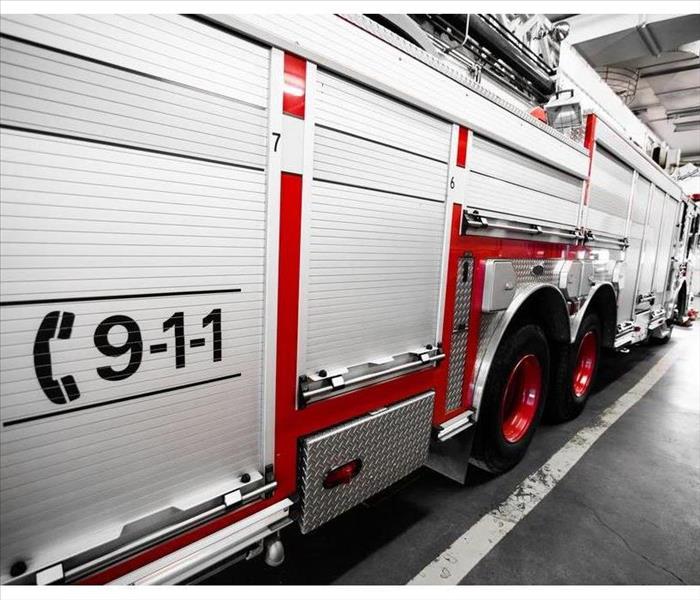 Call the fire department
Call the fire department
What to Do After a Kitchen Fire
Dealing with a kitchen fire in Raytown, MO, can be overwhelming and result in a lot of damage. To ensure that your restaurant, employees and customers stay safe, it’s crucial to take immediate action. From using a fire extinguisher to following an evacuation plan, there are a number of important steps that you must take as soon as a fire breaks out in order to prevent it from spreading. Follow this guide if you ever find yourself dealing with a fire emergency.
Call the Fire Department
As soon as a fire starts in your kitchen, you need to call for help. While you’re waiting for the fire department to arrive, be sure to sound the fire alarm in order to alert everyone in the building. Taking these steps helps to maintain a sense of order and keeps the situation under control.
Use a Fire Extinguisher
Fire extinguishers are lifesaving tools in the event of a fire. However, you need to be able to use one correctly so that it does its job successfully. To use an extinguisher, do the following:
- Pull the pin to break the tamper seal
- Point the nozzle at the fire’s base while aiming low
- Squeeze the handle to allow the agent to escape
- Aim the extinguisher at the fire’s base while sweeping from side to side
Following this procedure can enable you to fight the fire properly.
Evacuate the Building
You must evacuate the building immediately if you find that the fire extinguisher has failed to put out the fire. Be sure to leave the job to the fire department and focus on confirming that everyone has safely exited the restaurant. It’s vital to communicate a safety plan to your workers in advance so that everyone is prepared in case of a real fire.
If you notice any fire damage that occurs after a kitchen fire, call fire restoration services as soon as possible. Trusting professionals to restore your restaurant business can allow you to have peace of mind.
Responding to Primary and Secondary Water Damages
6/17/2019 (Permalink)
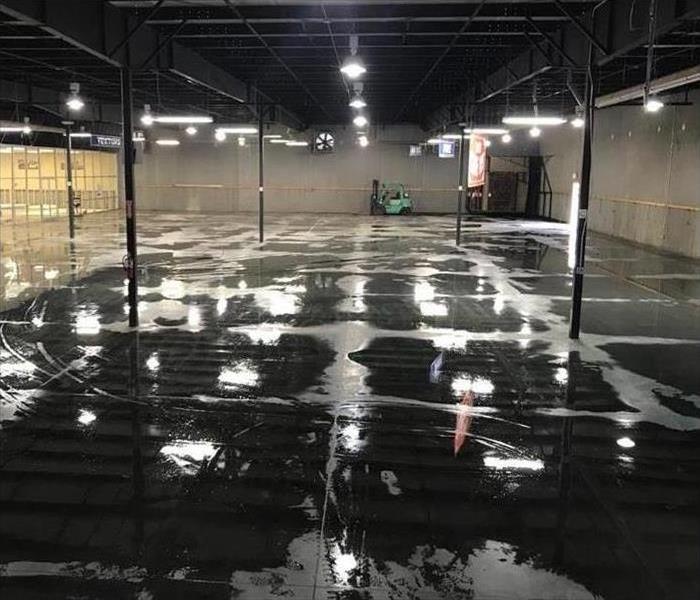 Commercial flood in Kansas City, MO
Commercial flood in Kansas City, MO
Responding to Primary and Secondary Water Damages
When a Kansas City, MO, property has been affected by high humidity, water leaks, or flooding, it's important to take steps to avoid secondary damage. In any of these situations and many others, the quick rush of water often leads to a quick rate of evaporation. This, in turn, saturates the air with humidity, and this high level of moisture in the air becomes responsible for the growth of black mold and other damages.
Primary Damages
This type of damage includes anything that happens at the type of the leak or flooding. It may include
- Broken pipes
- Waterlogged building materials
- Damaged furnishings
Secondary Damages
These include the harm done after the initial flood of water is over. Some examples of this are
- The growth of black mold
- Warped flooring
- Fabric degradation
As you prepared to address primary damages, it's important to recognize the potential for secondary harm and to take steps to prevent it.
Remove Water
Damage restoration efforts should begin as soon as possible when properties are affected by dripping faucets, burst pipes, or storm flooding. These efforts should include the use of commercial grade drying equipment, such as heaters and fans. Water restoration and cleanup professionals often have powerful extraction pumps to remove water quickly, reducing the risk of high humidity in the building. A quick, effective response is key to preventing moisture from spreading under walls and throughout porous materials in the building.
Reduce Moisture
Professionals may also use powerful dehumidifiers to take as much moisture out of the air as possible. This equipment quickly prevents condensation from moisture-rich air, further protecting rooms and belongings that hadn't yet been affected by the flooding. Finally, high-speed, high-volume fans should be installed throughout the affected area to constantly replace the humid air with dry air.
The growth of black mold is just one example of secondary damages that may affect your Kansas City, MO, property after any type of flooding. It's important to focus as much on preventing these follow-up damages as you do on responding to primary damages.
How To Eliminate Mold In Ductwork
4/11/2019 (Permalink)
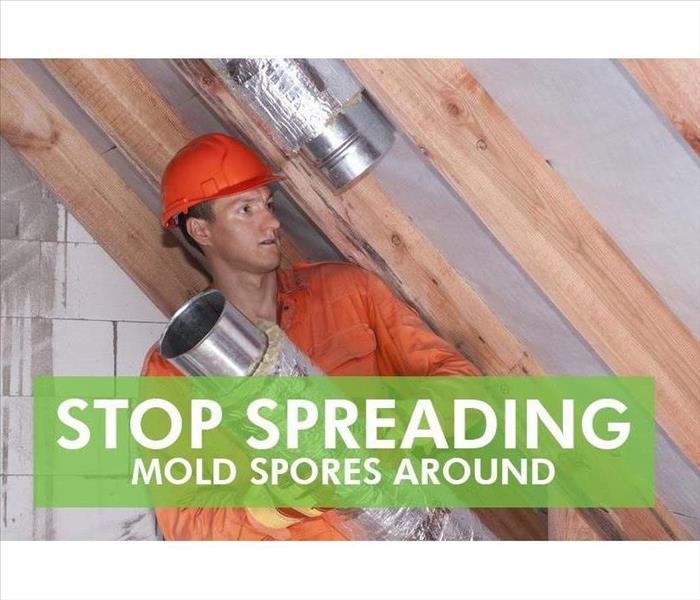 Mold spores can travel on the air currents throughout your home or business
Mold spores can travel on the air currents throughout your home or business
How To Eliminate Mold In Ductwork
High levels of moisture can cause mold to start growing inside HVAC ducts. Almost any type of mold, including black mold, can be supported by dust and debris inside of a heating and cooling system. Spores can spread throughout a structure through air ducts. If a musty odor is present or mold growth is evident, building owners or managers should take these three steps.
1. Locate the Source of Moisture
A building owner or manager should contact an HVAC specialist to identify the source of moisture and resolve the problem before scheduling a duct cleaning. Excessive moisture or mold growth may be evident in condensate drip pans, coils or terminal units. It is also possible that a plumbing or roof leak is introducing water directly into ductwork.
2. Clean the Air Ducts
A duct cleaning company can eliminate many types of mold. These services typically use high-powered vacuums to clean ducts. If black mold or signs of severe contamination are present, a property owner or manager may also want to consult with an indoor environmental professional. More extensive remediation work may be necessary if mold has spread beyond ducts.
3. Inhibit the Mold Growth
A duct cleaning company may also apply a mold inhibitor rated for HVAC use. This treatment can help to prevent mold from returning even if moisture levels increase. Property owners should keep moisture low by taking measures to prevent and quickly fix leaks, maintaining the HVAC system and ensuring that indoor relative humidity levels remain between 30 percent and 50 percent.
These measures can help eliminate the presence of mold growth from ductwork and prevent fungus from returning. If black mold is found or there is a significant chance that mold has spread to other parts of a structure, a property owner or manager should also contact a mold cleanup and remediation company in Kansas City, MO.
Get Your Business Back in Action
2/5/2019 (Permalink)
Flooding and water damage events in Raytown/East Kansas City commercial properties are often complex with numerous issues that require a knowledgeable and flexible response. Whether we're dealing with a small water cleanup or a large scale water event, we work quickly to assess each unique situation and isolate the damaged area. In many instances, normal operations can continue in a temporary space while we restore your facility.
Restoring Commercial Properties Presents Unique Challenges
Our professionals are trained to be mindful of legal and environmental concerns and strive to fully restore the damaged area while working within your budget. We understand that every hour spent cleaning up is an hour lost revenue & productivity. So when an emergency situation arises in your business, give us a call and we'll be there fast with the help you need.
About SERVPRO of Raytown/East Kansas City
SERVPRO of Raytown/East Kansas City specializes in the cleanup and restoration of commercial and residential property after a water damage event. Our staff is highly trained and certified in property damage restoration. From initial and ongoing training at SERVPRO's corporate training facility to regular IICRC-industry certification, rest assured our staff is equipped with the knowledge to restore your property!
Immediate Service in Raytown/East Kansas City, MO
10/30/2018 (Permalink)
SERVPRO of Raytown/East Kansas City provides 24-hour emergency service and is dedicated to being faster to any-sized disaster in Raytown/East Kansas City. We can respond immediately to your emergency and have the expertise to handle your restoration or cleaning needs.
- 24-Hour Emergency Service
- Faster to Any-Sized Disaster
- Highly Trained Restoration Technicians
- A Trusted Leader in the Restoration Industry
- Locally Owned and Operated
- Advanced Restoration and Cleaning Equipment
Have Questions? Call Us 24/7/365 at 816-737-8776
Residential Services
Whether your Raytown/East Kansas City home needs emergency flood damage or your upholstery cleaned, you can depend on us. Our technicians have extensive cleaning and restoration training and can make your property look its best. Learn more about our residential services:
- Water Damage Restoration
- Fire Damage Restoration
- Mold Remediation
- Storm Damage Restoration
- Cleaning Services
- Building/Reconstruction Services
Commercial Services
There's never a convenient time for fire or Water damage to strike your Raytown/East Kansas City commercial property. Every hour spent cleaning up is an hour of lost revenue and productivity. So, when the need arises for professional cleaning or emergency restoration services we have the training and expertise to respond promptly with highly trained technicians to get your property back to business. Learn more about our commercial services:
- Commercial Water Damage Restoration
- Commercial Fire Damage Restoration
Keeping Your Business Above Water After Water Damage
10/18/2018 (Permalink)
Flooding and water damage events at Raytown/East Kansas City commercial properties are often complex with numerous issues that require a knowledgeable and flexible response. Whether we’re dealing with a relatively small water cleanup scenario or a large scale event, we work quickly to assess each unique situation and isolate the damaged area. In many instances, normal operations can continue in a temporary space while we restore your facility.
Restoring Commercial Properties Presents Unique Challenges
Our professionals are trained to be mindful of legal and environmental concerns and strive to fully restore the damaged area while working within your budgetary constraints. We understand that every hour spent cleaning up is an hour of lost revenue and productivity. So when an emergency situation arises in your business, give us a call and we’ll be there fast with the help you need.
About SERVPRO of Raytown/East Kansas City
SERVPRO of Raytown/East Kansas City specializes in the cleanup and restoration of commercial and residential property after a water damage event. Our staff is highly trained in property damage restoration. From initial and ongoing training at SERVPRO’s corporate training facility to regular IICRC-industry certification, rest assured our staff is equipped with the knowledge to restore your property.
Why You Should Regularly Clean Your Building's Air Ducts/HVAC System
10/1/2018 (Permalink)
It's easy for the cleaning of air ducts and HVAC systems on your property to go forgotten, but it is important to keep up with regular HVAC maintenance. Like anything else in a home or business, air ducts accumulate dust and dirt over time. Other the factors that may increase the need for regular HVAC system cleaning are pets, occupants with allergies or asthma, cigarette or cigar smoke, water contamination or damage to the home HVAC system, or home renovation and remodeling projects. A general rule of thumb is that if your air ducts look dirty, then they probably are.
The National Air Duct Cleaning Associatoin (NADCA) recommends that dirty HVAC systems be inspected by a reputable, certified HVAC professional. Clean HVAC systems can result in an improved air quality of your home or business. Regular cleaning may also increase your energy savings and give your HVAC system a longer lifespan.
If air duct and HVAC system cleaning goes beyond the scope of your regular janitorial staff, or if you want cleaning done for your home's system, SERVPRO of Raytown/East Kansas City can help!
Inspecting a Commercial Property for Mold
8/16/2018 (Permalink)
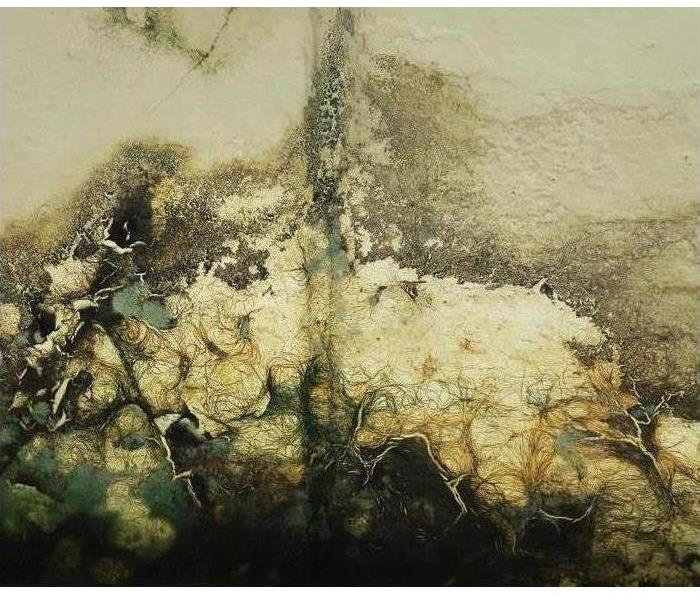 A mold inspection can remove at least one of the unknowns before a business adds a building to its property portfolio.
A mold inspection can remove at least one of the unknowns before a business adds a building to its property portfolio.
Buying a building is a significant investment for any businessperson, and there are a lot of moving parts to this type of transaction in Raytown/East Kansas City. Though it can be an expensive undertaking, hiring a professional to perform a mold inspection before the sale can head off major problems and remediation costs in the long term.
Where Mold Growth Can Be Problematic
To live in this world is to live with mold. At its best, it makes life better by contributing to the creation of bread, wine, cheese and some medicines, like penicillin. It does, of course, have serious drawbacks as well, though.
Prime spots in a building for a mold problem are well-known:
• Bathrooms are a place where mold can grow in grout, between wall tiles, and in the tub or shower.
• Windows that have been improperly sealed can allow moisture into walls or ceilings and facilitate mold growth. A mold inspection can reveal this to a potential buyer.
• Exterior doors without effective seals can allow moisture to collect and harbor mold.
Even slightly high humidity can facilitate the growth of mold. Experts recommend the prudent move of keeping indoor humidity levels below 45 percent.
Why Mold Growth Can Be Problematic
It isn’t only visible mold that can be troublesome to a property owner. Left unchecked, mold can destroy wood because it is an organism that feeds on surface nutrients. Mold that infiltrates drywall cannot be removed, and the affected area must be cut away. Carpets and insulation are also moisture-holding materials that mold can compromise to the point that they must be replaced.
Buying real estate can be a complicated process, and it is impossible to know everything there is to know about a building’s history or future. However, a mold inspection can remove at least one of the unknowns before a business adds a building to its property portfolio.
Common Causes of Commercial Water Damage
2/5/2018 (Permalink)
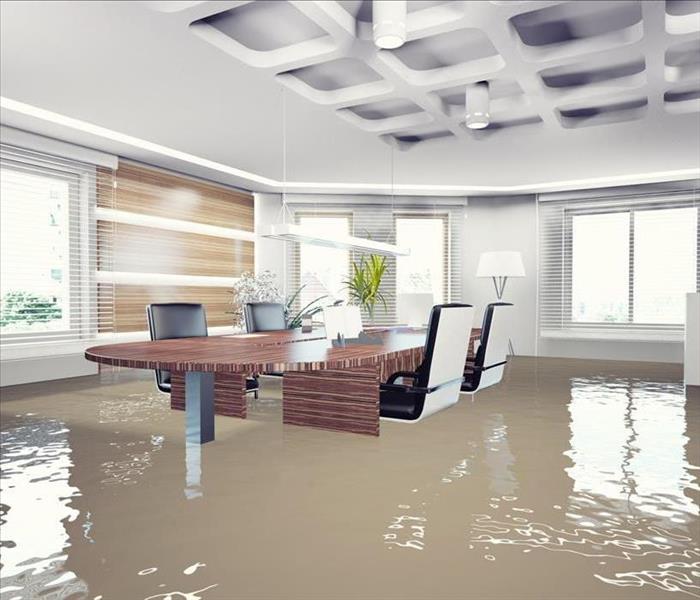 Call us today - 816-737-8776
Call us today - 816-737-8776
Usually when companies think about water damage in their building, they think the cause will be from a huge storm. Most of the time, that is the truth but there are other factors that cause water damage in commercial buildings.
1. Damaged Appliances - This problem is more common in restaurants where they have many different appliances that could cause a problem. If you have any equipment or appliance that involves water, you could have this particular water emergency.
2. Water Heaters - It is possible for water heaters to crack or lose their seal because of high pressure. You want to make sure and follow the manufacturers guidelines and flush your heater regularly to make sure it is working properly.
3. Roofing - One of the more obvious ways that you can tell that your building has water damage is seeing water leaking from your roof. Your roof might need to be resealed or it does not drain properly. If you notice a leak, even a small one, get it fixed ASAP.
4. Malfunctioning Sprinkler Systems - If you have an older building, sometimes the sprinkler systems work with the fire protection systems. You need to check the system to make sure that it is not faulty or in need of replacement to prevent unnecessary water damage.
5. Broken Pipes/Plumbing - During colder weather, it is more possible for pipes to break if you don’t continually run water through them. You need to take care of all pipes to make sure none of them burst.
6. Backed up Sewer Lines - This water emergency might be the most disgusting and one of the most dangerous. You will have contaminated black water flowing on the floors which can cause serious health effects.
If you experience any water damage to your commercial building, SERVPRO of Raytown/East Kansas City will get your building cleaned and up and running in no time.
Commercial Cleaning Services
10/31/2017 (Permalink)
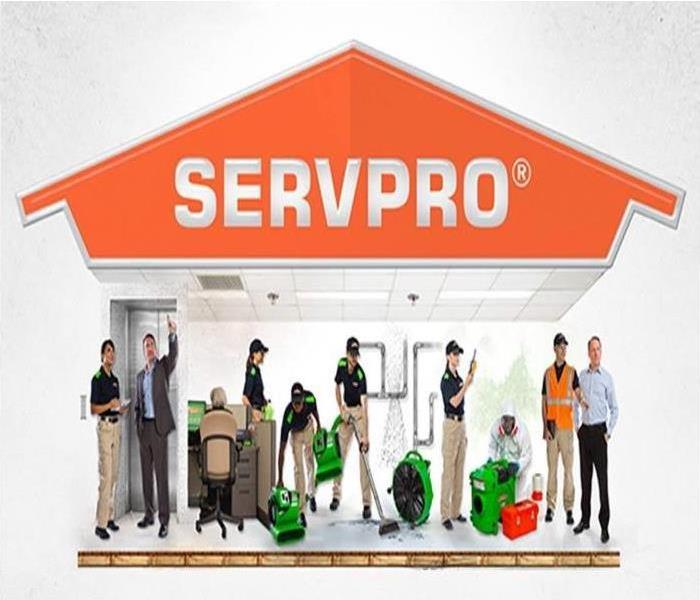 Call us today 816-737-8776
Call us today 816-737-8776
If you are a business owner, or run a particular business that receives a lot of visitors and foot-traffic, you know how important it is to keep your business looking clean and in good shape. A lot of times, you don't have the time to worry about the common wear and tear that gradually soils your office.
When grime, odor, and moisture challenges go beyond the scope of your regular janitorial staff, you should call SERVPRO of Raytown/East Kansas City for prompt service. Whether it’s removing an odor problem or deep cleaning flooring or carpets, you can rely on us to make your workspace look its very best.
SERVPRO of Raytown/East Kansas City offer cleaning services ranging from cleaning restaurant hoods to removing biohazard contaminants. We have the specialized training and products to get your property back to business. Our cleaning services include the following:
- Air Ducts and HVAC
- Biohazard and Sewage
- Trauma and Crime Scene
- Carpet and Upholstery
- Drapes and Blinds
- Ceilings, Walls, and Hard Floors
- Odor Removal and Deodorization
- Vandalism
The Different Causes of Commercial Water Damage
10/19/2017 (Permalink)
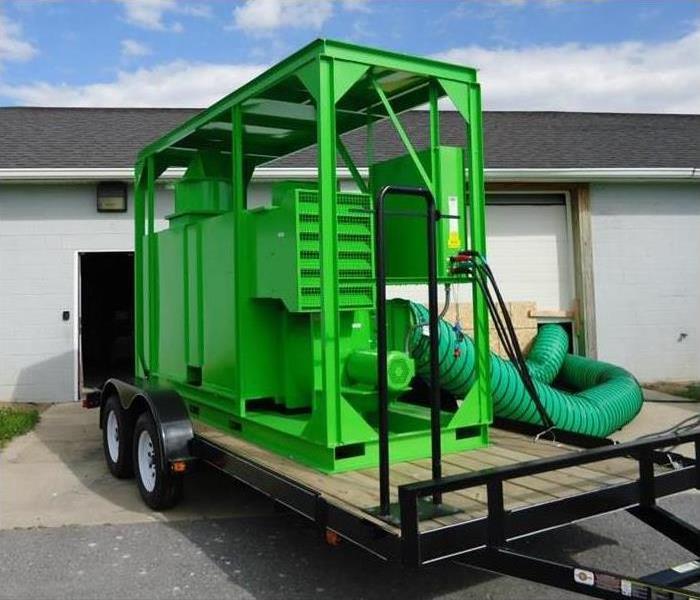 Speciality drying equipment for large commercial water damages.
Speciality drying equipment for large commercial water damages.
Work Place Water Damage is Restored by SERVPRO
When business owners visualize water damage, they often picture a massive storm wiping out power lines, flooding offices, and shutting down businesses for days at a time. It is true that commercial water damage is often the result of floods and water that stems from weather events and storms.
However, many entrepreneurs and business space renters forget that storms and severe weather aren't the only causes of floods and water damage. Here are some of the typical causes of water damage to commercial buildings.
1. Malfunctioning sprinkler systems
Some older office and retail buildings still have outdated sprinkler systems that work in conjunction with fire protection systems. While such sprinklers can come in handy during a fire emergency, they can also cause commercial flood damage if they are faulty or in need of replacement. This could easily damage inventory and business assets.
2. Damaged appliances and equipment
This cause of commercial flood damage is more common in restaurants and catering facilities, as well as any business that has appliances and equipment that make use of water. If the appliance fails and sends water across your building, especially during late hours when no one is around, you may come back to work and face a water emergency.
3. Broken pipes and plumbing
Just like in a residence, if the plumbing system in your workplace fails water damage could be the result.
4. Backed up sewer lines
This is another cause of commercial water damage that often catches business owners by surprise. Should the sewer line to your building back up or become damaged, realize the potential dangers of contaminated Black Water which can cause health effects and ruin products and office furnishings.
Do you Have a Smelly Restaurant?
10/2/2017 (Permalink)
 Keep your restaurant fresh for your customers and employees!
Keep your restaurant fresh for your customers and employees!
Does your Raytown/East Kansas City restaurant smell like a bad recipe? Do you have customers come into your place and wrinkle up their nose? Or they walk in and then leave without ordering anything. You know you’re in need of odor removal when customers suddenly lose their appetite when entering your restaurant in Raytown/East Kansas City. We know it’s not a pleasant topic, but it’s one we, at SERVPRO of Raytown/East Kansas City, have experience correcting! So, how can we help you with your odor problems? Read on and discover 3 ways we will get your restaurant sweet-smelling once again.
Deep cleaning
Sometimes you need a bit more than the everyday cleaning job your staff does. Just like we do deep cleaning a couple times a year in our homes, it is essential to have this done in our restaurants as well. Restaurants enjoy a thorough cleaning of the floors, drapes, blinds, carpeting, and upholstery. Food smells can become trapped in fabrics leaving a sour or greasy smell. We have specialty cleaning services to ensure your restaurant gets deep cleaned.
Deodorization
Not only does your Raytown/East Kansas City restaurant need a deep cleaning, but it needs an odor removal process using deodorization. Our staff is trained to discover what is causing the odors. This is an important first step in eliminating the odors. Once our staff knows where the smell is emanating from, then we can use the proper formula to remove it. We have several different deodorizing formulas created to get to the source of the bad smells. Odor removal is not just about hiding or covering up offending smells, but it’s essential to go to the root of the problem and neutralize it.
Inspect for mold
Mold is one thing that not only leaves a musty odor, but it has a negative impact on your health. That’s why it’s so important to determine if mold is the culprit and, if so, to begin action right away to combat it. We have tools and equipment that help us determine if there is a mold problem. It doesn’t take much for mold to develop and then spread. If you suspect mold, we will discover the source and work to isolate, then eliminate it.
We make cleaning and restoration our expertise. We train and educate our staff to combat stinky smells wherever they may be. If you have a restaurant that does not smell too sweet, contact us today.
Commercial Damage in the Food Service
9/26/2017 (Permalink)
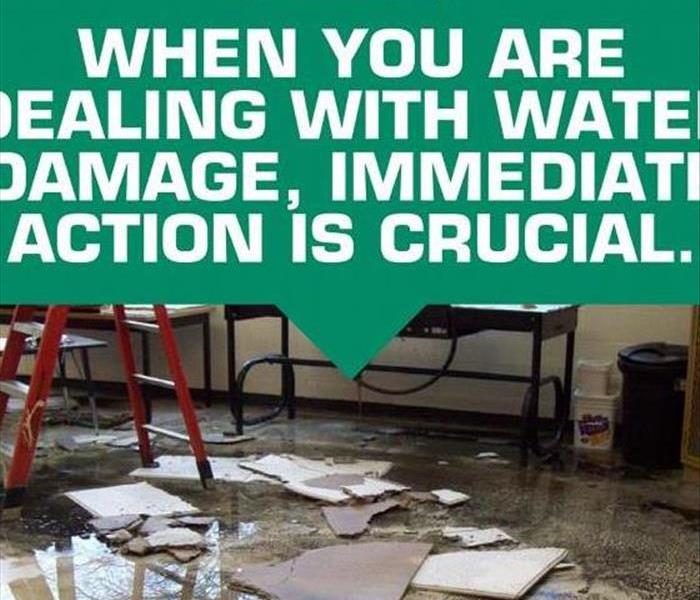 When you are facing commercial water damage, call SERVPRO to assess.
When you are facing commercial water damage, call SERVPRO to assess.
Don't Let Water Damage Ruin Your Business
For a local bakery, the chemical agents we use for cleaning may not be an option. Food is very sensitive to absorbing orders, and even the lingering odor from a strong antimicrobial agent could render ingredients useless and serving areas irritating to customer's noses.
This means that cleaning up commercial water damage in a bakery may take a bit longer. Instead of using cleaning agents, our technicians here at SERVPRO will rely on the air moving equipment in our inventory to dry the building and reopen the doors for business.
Lower speed air movers work well to push wet air out of a room or hallway. By using a shroud with them to direct the air, these movers are also excellent for drying out the moisture that can be trapped between sheets of drywall or under cabinets.
The air movers we use are designed to not just dry out a room, but with the right attachment (a special clamp), our higher speed models can also be used to dry out a carpet and carpet pad in less than a day. If we can start this process quickly enough after standing water has been removed (and if the water was not contaminated), then we can restore most carpeted areas in a day or two without the need of chemical cleaning agents.
For large areas such as kitchens, we will use venting box fans to exchange the wet air for dry air. It is also in areas like this with large surfaces (preparations tables) where we may need to use some cleaning agents. The box fans will speed up removing odors as our technicians employ the chemical cleaners.
Restoring a food service business brings its own set of problems. SERVPRO of Raytown/East Kansas City has the experience and the equipment to get the job done. If you have a water problem in your business, call us today at 816-737-8776 to begin restoration and get your doors open to customers once more.
Benefits for Commercial Clients
8/17/2017 (Permalink)
 A broken water main resulting in partial foundation replacement.
A broken water main resulting in partial foundation replacement.
Commercial Property Managers
If you work in the property management industry you understand the value of a quick response and fast turn round time when it comes to an emergency situation. A quick response time can mean a reduction in the size and scope of the damage, it can also mean the difference between having a chance at saving business critical documents and equipment for the clients that are most important to you.
Commercial Client Benefits
Choosing SERVPRO of Raytown/East Kansas City for your commercial damage mitigation accrues you benefits not limited to:
- Working with you to tailor the solution to you, priding ourselves in accurate and straightforward communication.
- Every large commercial loss is supervised by a local commercial operations manager to help ensure seamless communication and timely mitigation.
- The SERVPRO Commercial Large Loss Division is composed of our best of the best in restoration. Our elite large-loss specialists are pre-qualified and strategically positioned throughout the United States to handle any size disaster.
Call us Today!
Contact the Commercial Fire and Water damage experts at SERVPRO of Raytown/East Kansas City when you discover damage at your business. 816-737-8776 to set up an appointment for an inspection and consultation.
SERVPRO: Your Experts in Commercial Water Damage in Raytown/East Kansas City
8/1/2017 (Permalink)
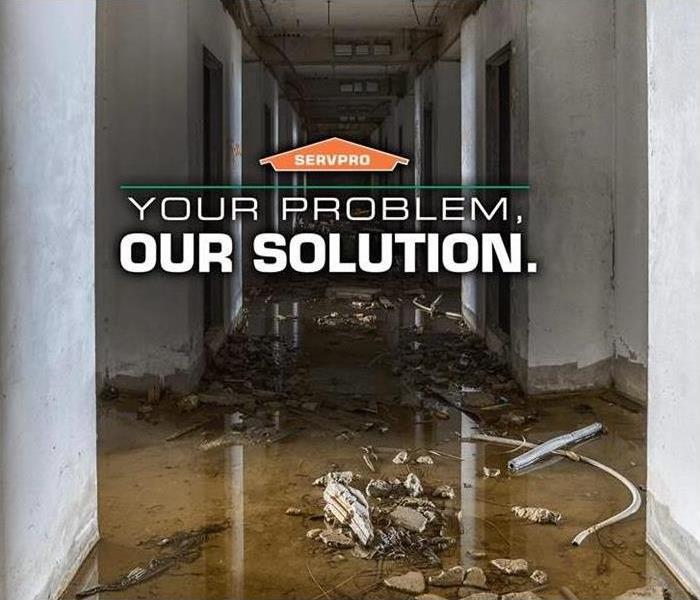 Have Questions? Call Us Today - (816)737-8776
Have Questions? Call Us Today - (816)737-8776
If you have recently become a victim of commercial water damage in Raytown/East Kansas City, MO, you may be wondering what you can do to mitigate your damages. There is a critical period in which certain actions must be taken to preserve as much of your property as possible and to decrease any health risks when water damage has occurred in a commercial space.
Preparing a Space for Water Damage Restoration
Before you enter your commercial space or any flooded building, you will need to make sure the electrical power to the structure is shut off. You should also be aware that during a flooding event, small animals or reptiles tend to seek shelter inside of buildings. Be prepared to deal with the discovery of wild animals in your space.
Protect yourself from entering any flooded building by wearing an organic vapor respirator. You can purchase these at any local paint and building supply stores. You also want to have rubber gloves, protective clothing, and eye protection. The first thing you should do is ventilate the affected areas by opening the windows and placing fans where possible.
Unfortunately, there likely will be items that you need to throw away. Any items that are porous and have absorbed contaminated floodwater cannot be restored. If your commercial space has drywall, mattresses, pillows, box springs, particle board, carpets or carpet pads, these will need to be discarded if they have become saturated. However, there is good news: If you have clothing or household fabrics that can be machine-washed, you may be able to salvage them. Use your washing machine to clean these items with a 10-minute soak at the minimum in hot water with detergent. The soap and normal wash should remove most of the contamination and any staining that is present.
Be aware that your commercial space will need a thorough professional inspection, cleaning and possibly restructuring. Water damaged walls and installations must be removed and repaired, and pockets of saturation should be exposed for drying and sanitizing. Always remember that mold growth could take a few days to appear as it thrives in a moist environment with organic-type materials such as paper or particle board and in temperatures that range between 60 and 86 degrees Fahrenheit. Keep good airflow throughout the interior environment, and maintain moderate temperatures to decrease the risk of any mold growth. It is also important that you let your space dry out before any rebuilding occurs.
Services You Can Count On in Raytown/East Kansas City, MO
You can depend on SERVPRO to provide reasonable prices for commercial damages and other services in the Raytown/East Kansas City area. Our restoration services include cleanup after water damage, fire damage, and storm damage. We also assist with mold remediation, and we're qualified to provide cleaning and building services. Our trained and certified IICRC technicians are available 24 hours a day, seven days a week to begin your restoration.





 24/7 Emergency Service
24/7 Emergency Service








